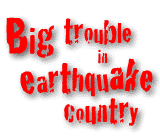 |
Part B: Background Information
EARTHQUAKE SAFETY |
Read over the following material to gain a better understanding of
issues surrounding earthquake safety.
Page Index
Emergency Information
- The best protection during an earthquake is to get under heavy furniture such
as a desk, table, or bench
- The greatest danger exists directly outside buildings, at exits, and alongside
exterior walls. Many of the 120 fatalities from the 1933 Long Beach earthquake occurred
when people ran outside of buildings only to be killed by falling debris from collapsing
walls.
- Ground movement during an earthquake is seldom the direct cause of death or injury.
Most earthquake-related casualties result from collapsing walls, flying glass, and
falling objects.
Danger Zone
Earthquakes occur most frequently west of the Rocky Mountains, although historically
the most violent earthquakes have occurred in the central United States. All 50 states
and all U.S. territories are vulnerable to earthquakes. Forty-one states or territories
are at moderate to high risk.
What Is An Earthquake?
An earthquake is a sudden, rapid shaking of the Earth caused by the breaking and
shifting of rock beneath the Earth's surface. This shaking can cause buildings and
bridges to collapse; disrupt gas, electric, and phone service; and sometimes trigger
landslides, avalanches, flash floods, fires, and huge, destructive ocean waves (tsunamis).
Buildings with foundations resting on unconsolidated landfill, old waterways, or
other unstable soil are most at risk. Buildings or trailers and manufactured homes
not tied to a reinforced foundation anchored to the ground are also at risk since
they can be shaken off their mountings during an earthquake. Earthquakes can occur
at any time of the year.
Help Your Community Get Ready
The media can raise awareness about earthquakes by providing important information
to the community. Here are some suggestions:
- Publish a special section in your local newspaper with emergency information
on earthquakes. Localize the information by printing the phone numbers of local emergency
services offices, the American Red Cross, and hospitals.
- Conduct a week-long series on locating hazards in the home.
- Work with local emergency services and American Red Cross officials to prepare
special reports for people with mobility impairments on what to do during an earthquake.
- Provide tips on conducting earthquake drills in the home.
- Interview representatives of the gas, electric, and water companies about shutting
off utilities.
DID YOU KNOW...
- Many people think of California as "Earthquake Country," but the state
with the most major earthquakes is Alaska. The grandaddy of earthquakes was along
the New Madrid Fault in Missouri where a 3-month long series of quakes in 1811--1812
included th ree quakes larger than a magnitude of 8. These quakes were felt over
2 million square miles.
- The Richter Scale was developed by Charles F. Richter in 1935. It is a logarithmic
measurement of the amount of energy released by an earthquake. Earthquakes with a
magnitude of at least 4.5 are strong enough to be recorded by sensitive seismographs
all over the world. In the United States several thousand shocks of varying sizes
occur annually.
- The effects of earthquakes are also measured by the Modified Mercalli Intensity
scale. The intensity of a quake is evaluated according to the observed severity of
the quake at specific locations. The Mercalli scale rates the intensity on a Roman
nu meral scale that ranges from I to XII.
- The Loma Prieta (northern California) earthquake of October 1989 registered 7.1
on the Richter scale and as high as XI on the Mercalli scale.
Source:
Federal Emergency Management Agency (FEMA)
http://www.fema.gov/fema/quakef.html 
Copyright © 1997 Regents of the University of California
Updated
August 02, 2000


![]()
